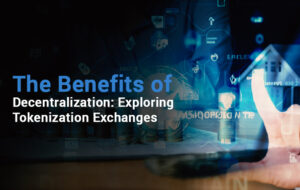The concept of tokenisation has emerged as a revolutionary way to digitise and trade real-world assets. This innovative approach leverages distributed ledger technology (DLT) to convert physical assets, such as real estate, art, and commodities, into digital tokens. In this blog, we will explore the benefits of tokenisation, how it works, and the industries that are adopting this technology.
What is Tokenisation?
Tokenisation is converting the ownership rights of a real-world asset into digital tokens on a DLT network. Each token represents a fraction of the real-world asset’s value and can be traded, transferred, and stored securely on DLT. This process enables fractional ownership, increased liquidity, and access to a global market of investors.
How Does Tokenisation Work?
Asset Identification: The first step in tokenisation is to identify the real-world assets to be tokenised, such as real estate, art, or commodities.
Legal and Regulatory Compliance: Once the asset is identified, legal and regulatory compliance must be ensured to meet the requirements of the jurisdiction in which the asset is located.
Token Creation: Digital tokens representing ownership rights in the asset are created on a DLT. Each token is unique and represents a fraction of the total value of the real-world asset.
Trading and Exchange: The tokens can then be traded on digital asset exchanges, providing investors with increased liquidity and the ability to buy and sell fractions of assets.
Benefits of Tokenisation
Increased Liquidity: Tokenisation enables real-world assets that are traditionally illiquid, such as real estate and art, to be traded on digital asset exchanges, increasing their liquidity.
Fractional Ownership: Tokenisation allows investors to purchase fractions of high-value real-world assets, making them more accessible to a wider range of investors.
Global Market Access: By tokenising real-world assets, investors from around the world can access previously inaccessible markets, increasing the potential investor base.
Transparency and Security: DLT provides a transparent and secure way to record transactions, reducing the risk of fraud and ensuring the integrity of the ownership records.
Industries Utilising Tokenisation
Real Estate: Tokenisation of real estate assets allows investors to invest in properties without the need for large amounts of capital, increasing accessibility and liquidity in the real estate market.
Art and Collectibles: Tokenisation of art and collectibles enables investors to own fractions of valuable artworks, making these real-world assets more accessible to a wider range of investors.
Commodities: Tokenisation of commodities such as gold and silver allow investors to trade these real-world assets on digital exchanges, providing increased liquidity and accessibility.
Venture Capital: Tokenisation of venture capital funds enables investors to invest in startups and early-stage companies, providing liquidity and diversification in the venture capital market.
Why and How Tokenisation Should be Utilised
Tokenisation offers numerous benefits for investors and asset owners alike. By digitising real-world assets, tokenisation increases liquidity, accessibility, and transparency in the market. It also opens new opportunities for fractional ownership and global market access. As industries continue to adopt tokenisation, it is crucial for investors and asset owners to understand the potential benefits and risks associated with this innovative technology.
Kalptantra is a pioneering regulated permissioned decentralised coalition DLT that powers the SMART Exchange platform. This platform uses tokenisation to allow investment in real-world assets in a secure, innovative, and user-friendly way. By making real estate investment more accessible, SMART Exchange aims to support specialised businesses. With its structured approach, strict security, and commitment to compliance, the platform offers an appealing option for diversified and efficient investing. Its regulation, security measures and focus on usability and compliance make it stand out as an accessible way to add real assets to an investment portfolio.
Conclusion
Tokenisation represents a fundamental shift in how we perceive and interact with real-world assets. By digitising assets and making them more accessible and tradable, tokenisation has the potential to democratise investment opportunities and create a more efficient and transparent market. As industries continue to embrace this technology, it is crucial for investors and asset owners to stay informed and adapt to the changing landscape of real-world asset ownership and investment. Tokenisation is not just a technological innovation; it is a catalyst for change that has the power to reshape industries and redefine the concept of ownership in the digital age.




